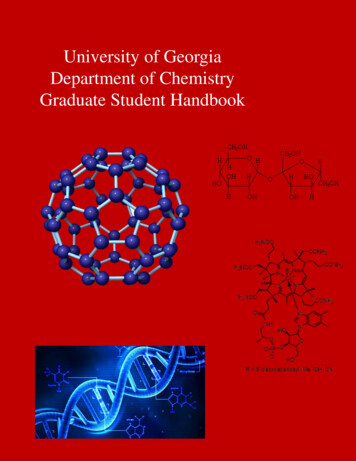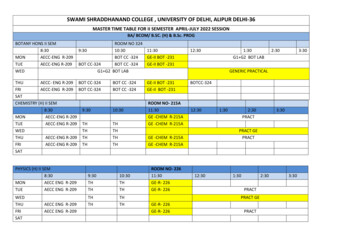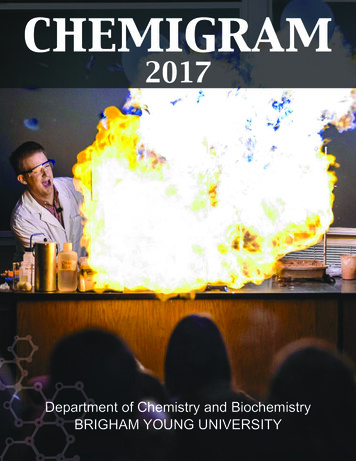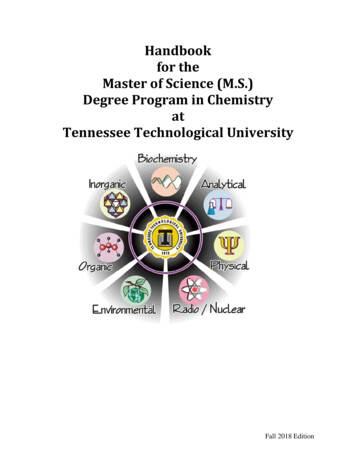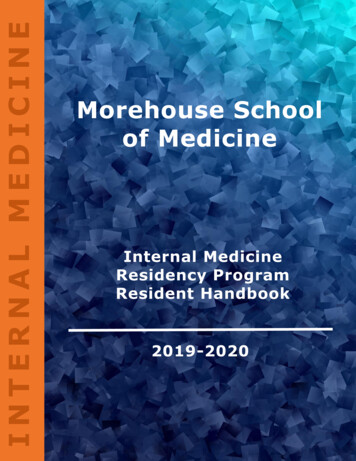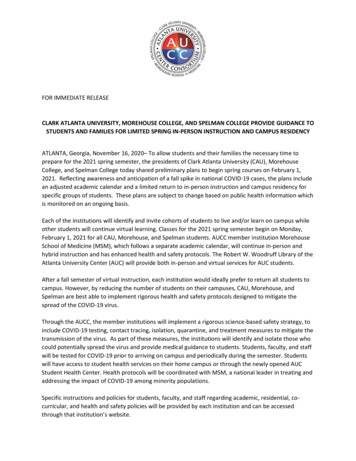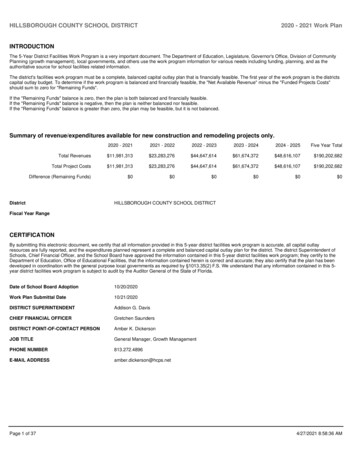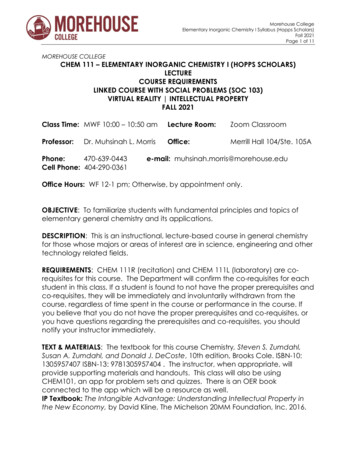
Transcription
Morehouse CollegeElementary Inorganic Chemistry I Syllabus (Hopps Scholars)Fall 2021Page 1 of 11MOREHOUSE COLLEGECHEM 111 – ELEMENTARY INORGANIC CHEMISTRY I (HOPPS SCHOLARS)LECTURECOURSE REQUIREMENTSLINKED COURSE WITH SOCIAL PROBLEMS (SOC 103)VIRTUAL REALITY INTELLECTUAL PROPERTYFALL 2021Class Time: MWF 10:00 – 10:50 amLecture Room:Zoom ClassroomProfessor:Office:Merrill Hall 104/Ste. 105ADr. Muhsinah L. MorrisPhone:470-639-0443Cell Phone: 404-290-0361e-mail: muhsinah.morris@morehouse.eduOffice Hours: WF 12-1 pm; Otherwise, by appointment only.OBJECTIVE: To familiarize students with fundamental principles and topics ofelementary general chemistry and its applications.DESCRIPTION: This is an instructional, lecture-based course in general chemistryfor those whose majors or areas of interest are in science, engineering and othertechnology related fields.REQUIREMENTS: CHEM 111R (recitation) and CHEM 111L (laboratory) are corequisites for this course. The Department will confirm the co-requisites for eachstudent in this class. If a student is found to not have the proper prerequisites andco-requisites, they will be immediately and involuntarily withdrawn from thecourse, regardless of time spent in the course or performance in the course. Ifyou believe that you do not have the proper prerequisites and co-requisites, oryou have questions regarding the prerequisites and co-requisites, you shouldnotify your instructor immediately.TEXT & MATERIALS: The textbook for this course Chemistry, Steven S. Zumdahl,Susan A. Zumdahl, and Donald J. DeCoste, 10th edition, Brooks Cole. ISBN-10:1305957407 ISBN-13: 9781305957404 . The instructor, when appropriate, willprovide supporting materials and handouts. This class will also be usingCHEM101, an app for problem sets and quizzes. There is an OER bookconnected to the app which will be a resource as well.IP Textbook: The Intangible Advantage: Understanding Intellectual Property inthe New Economy, by David Kline, The Michelson 20MM Foundation, Inc. 2016.
Morehouse CollegeElementary Inorganic Chemistry I Syllabus (Hopps Scholars)Fall 2021Page 2 of 11COURSE PRESENTATION: Course presentation will be in the form of lectures,demonstrations, and presentations. Lectures will consist of reviews from previousreadings and lots of problem solving. Make sure to bring notes, problem sets, ascientific calculator, and additional questions to lecture each class period.ATTENDANCE: Morehouse College attendance rules will be enforced. Thestudent is REQUIRED to be on time for the class. Any student who is more thanfive minutes late will not be allowed to attend the class. Any student whoexceeds three unexcused absences will be withdrawn from the course.Students are expected to attend all class meetings. In the event of absence, itis the student’s responsibility to obtain assignments and information coveredduring the absence. It is also the student’s responsibility to complete withdrawalthrough the Office of the Registrar in the event that this becomes necessary.Students should also plan to arrive to class on time. The instructor reserves theright to deny classroom entry of tardy students. Withdrawal from lectureautomatically requires withdrawal from the lab and vice versa. Attendance istaken each class period and required. The attendance will be entered intoStarfish and flags will notify your advisors, instructors, and administration of anylapse in attendance. Attendance does affect your financial aid.COURSE DESCRIPTION AND GRADING: Students must earn a grade of C or betterto pass the course. If a student receives a grade of C- or less, they will not beallowed to register in the next course in the chemistry sequence. All grades arefinal! No adjustments to grades will be made after the close of semester, exceptfor the grade of incomplete, I (see below). There will be four-hour exams and thefinal exam. The final exam is required. No make-up exams will be given withoutan official College excuse. The course grade is obtained by averaging the threehighest hour exams and the final exam, which weighs twice as heavily as anindividual hour exams. If one of the class exams is missed that exam becomesthe dropped exam. The grading scale is as 5-6860-64A AAB BBC CCD
Morehouse CollegeElementary Inorganic Chemistry I Syllabus (Hopps Scholars)Fall 2021Page 3 of 1155-5950-540-50QuizzesProblem SetsExamsFinal ExamDDF25%15%35%25%Evaluation ScaleINCOMPLETE: A grade of incomplete will be given only when a student hascompleted the majority of the course requirements, as specified by theinstructor and provide a written excuse, signed by the appropriate universityofficial excuse (e.g., Dean of Students, Division Dean, etc.) indicating alegitimate reason for not completing the course by the close of semester, isprovided by the Vice President of student affairs. The student must completethe required course work in the next semester on or before the date indicatedby the Registrar’s Office or the grade will be converted into an “F”.ACADEMIC HONESTY: The College’s policy on academic honesty will be strictlyenforced. Cheating on homework, quizzes, and examinations will not betolerated and will result in a grade of zero on the assignment for the first offense,and in immediate involuntary withdrawal from the course with a failing grade,for a second offense. Plagiarism is a violation of the Honor Code and will bepunished with a grade of zero on the assignment for the first offense and agrade of “F” on the course for the second offense. Cheating and plagiarism willnot be tolerated. Cheating or plagiarism will result in a zero for the exam orpaper. A second offense will result in an F grade and be reported to the studentcourt.DISRUPTIVE ACTIONS: Students are expected to act with respect for theprofessor and fellow students. If late, enter and take a seat quietly. Talking toothers in the class during lecture/discussion prevents others from hearing theproceedings. Leaving class during session is disruptive and should occur only inan emergency. Disruptive persons will be warned.TIME REQUIREMENTS: The amount of time outside of class needed to besuccessful in this class varies with background, study skills, interest, motivation,
Morehouse CollegeElementary Inorganic Chemistry I Syllabus (Hopps Scholars)Fall 2021Page 4 of 11and intellectual ability. To be successful, expect 8 or more hours per weekoutside of class to study and do homework. Students must develop skill in solvingproblems and this can only be obtained by doing the homework. The laboratorycomponent is separate and requires additional time. Expect approximately 3hours at home to prepare for lab sessions, calculate results, and prepare reports.Careful attention and good use of class time can reduce the time requiredoutside of class.PROBLEM SETS AND QUIZZES: Problem sets and other homework will becompleted and autograded on the CHEM 101 app. Quizzes will be givenregularly and are generally announced. These will also be taken on the CHEM101 app. There may be unannounced “pop” quizzes in class or quizzes will betaken in the first 5 minutes of class using the CHEM 101 app. It is recommendedthat you form a study group with classmates that will meet regularly.DISABILITIES AND IMPAIRMENTS: Morehouse College is an equal opportunityemployer and educational institution. The College makes reasonableaccommodations for all qualified individuals with disabilities. Any studentrequesting academic accommodations based on his disability is required toregister with our Student Counseling & Student Accessibility Services Center (the“Center”) by emailing SAS@morehouse.edu every semester. A disabilityaccommodation letter can be obtained from the Center.DISCLAIMER: The syllabus is not a contract between the instructor and thestudent, but rather a guide to course procedures. The instructor reservesthe right to amend the syllabus when conflicts, emergencies orcircumstances so dictate. In such cases, students will be duly notified.Similarly, the instructor reserves the right to alter the course content andassignments based on new materials, class discussions, or other legitimatepedagogical objectives.EDUCATIONAL OUTCOMES: At the end of this lecture course, students should beable to:CHAPTER ONE: CHEMICAL FOUNDATIONSSection One: To appreciate the importance of creative problem solving.Section Two: To identify the principal operations and limitations of the scientific method. Section Three: To describe the SIsystem of units and prefixes.Section Four: To identify causes of uncertainty in measurement. To show how significant figures are used. To compareprecision and accuracy in measurement.Section Five: To show how to determine the number of significant figures in a calculated result.Section Six: To show a general method of solving problems.Section Seven: To show how to convert units between the English and metric systems. Section Eight: To demonstrateconversions among the Fahrenheit, Celsius, and Kelvin temperature scales.Section Nine: To illustrate calculations involving density.Section Ten: To show how matter can be classified into subgroups.
Morehouse CollegeElementary Inorganic Chemistry I Syllabus (Hopps Scholars)Fall 2021Page 5 of 11CHAPTER TWO: ATOMS, MOLECULES, AND IONSSection One: To give a brief account of early chemical discoveries.Section Two: To describe and illustrate the laws of conservation of mass, definite proportion, and multiple proportions.Section Three: To describe Dalton's theory of atoms and show the significance of Gay-Lussac's experiments.Section Four: To summarize the experiments that characterized the structure of the atom. Section Five: To describefeatures of subatomic particles.Section Six: To introduce basic ideas of bonding in molecules. To show various ways of representing molecules.Section Seven: To introduce various features of the periodic table.Section Eight: To demonstrate how to name compounds given their formulas and to write formulas given their names.CHAPTER THREE: STOICHIOMETRYSection One: To give a brief account of early chemical discoveries.Section Two: To describe and illustrate the laws of conservation of mass, definite proportion, and multiple proportions.Section Three: To describe Dalton's theory of atoms and show the significance of Gay-Lussac's experiments.Section Four: To summarize the experiments that characterized the structure of the atom. Section Five: To describefeatures of subatomic particles.Section Six: To introduce basic ideas of bonding in molecules. To show various ways of representing molecules.Section Seven: To introduce various features of the periodic table.Section Eight: To demonstrate how to name compounds given their formulas and to write formulas given their names.CHAPTER FOUR: CHEMICAL REACTIONS AND SOLUTION STOICHIOMETRYSections 1-10: Students should be able to:Name compounds and write formulas for binary compounds, ternary compounds (those with polyatomic ions), andacids.Memorize the chemical formulas and charges of the polyatomic ions and the most common transition metal ions.Classify reactions by type.Write balanced molecular equations, complete ionic equations, and net ionic equations.Predict if a precipitate will form (Solubility rules; Focus specifically on: that ALL Na , K , NH4 , and NO3- salts are soluble)Perform calculations with different solution concentrations such as molarity and dilution.Describe how to prepare solutions and to use titration data to determine the molarity (concentration) of solutions.For reactions in solution, given the molarity and the volume of the reactants, calculate the amount of product producedor the amount of reactant required to react.Identify a reaction as oxidation-reduction based on evidence of electron transfer and balance the reaction equation.Predict products of reactions given the chemical names of the reactants.CHAPTER FIVE: GASESSection One: To demonstrate atmospheric pressure and explain how barometers work. To define the various units ofpressure.Section Two: To describe certain laws that relate the volume, pressure, and temperature of a gas and to do calculationsinvolving these laws.Section Three: To define the ideal gas law. To show how to do calculations involving the ideal gas law.Section Four: To define the molar volume for an ideal gas. To define STP. To show how to do stoichiometric calculationsfor reactions involving gases. To show how to calculate molar mass from gas density.Section Five: To state the relationship between partial pressures and total pressure and between partial pressure andmole fraction. To show how to obtain the molecular formula, given the empirical formula and the molar mass.Section Six: To present the basic postulates of the kinetic molecular theory. To define temperature. To show how tocalculate and use root mean square velocity.Section Seven: To describe effusion and diffusion. To show the relationship between effusion and diffusion.Section Eight: To describe how real gases deviate from ideal behavior. To show how van der Waals's equation allows forreal conditions.Section Nine: To characterize several real gases.Section Ten: To characterize the composition of the atmosphere. To describe some of the chemistry of air pollution.CHAPTER SEVEN: ATOMIC STRUCTURE AND PERIODICITYSection One: To characterize electromagnetic radiation in terms of wavelength, frequency, and speed.Section Two: To introduce the concept of quantized energy. To show that light has both wave and particulateproperties. To describe how diffraction experiments were used to demonstrate the dual nature of all matter.Section Three: To show that the line spectrum of hydrogen demonstrates the quantized nature of the energy of itselectron.Section Four: To describe the development of the Bohr model for the hydrogen atom. Section Five: To show howstanding waves can be used to describe electrons in atoms. To describe the Heisenberg uncertainty principle. To explainthe significance of electron probability distributions.Section Six: To explain the quantum numbers n, l, and ml.
Morehouse CollegeElementary Inorganic Chemistry I Syllabus (Hopps Scholars)Fall 2021Page 6 of 11Section Seven: To describe the shapes of orbitals designated by s, p, d, and f and to discuss orbital energies.Section Eight: To define electron spin and the electron spin quantum number. To explain the Pauli exclusion principle.Section Nine: To show how the quantum mechanical model can be applied to atoms besides hydrogen.Section Ten: To trace the development of the periodic table.Section Eleven: To explain the Aufbau principle.Section Twelve: To show general trends in ionization energy, electron affinity, and atomic radius in the periodic table.Section Thirteen: To show what types of information can be obtained from the periodic table.CHAPTER EIGHT: BONDING: GENERAL CONCEPTSSection One: To explain why an ionic bond is formed. To explain why a covalent bond is formed. To introduce the polarcovalent bond.Section Two: To discuss the nature of a bond in terms of electronegativity.Section Three: To define the relationship between bond polarity and molecular polarity. Section Four: To show how topredict the formulas of ionic compounds. To discuss the factors governing ion size.Section Five: To define lattice energy and show how it can be calculated.Section Six: To show the relationship between electronegativity and the ionic character of a bond.Section Seven: To discuss the covalent bonding model.Section Eight: To show how bond energies can be used to calculate heats of reaction. Section Nine: To introduce thelocalized electron model.Section Ten: To show how to write Lewis structures.Section Eleven: To show how to write Lewis structures for certain special cases.Section Twelve: To illustrate the concept of resonance. To show how to write resonance structures.Section Thirteen: To describe how molecular geometry can be predicted from the number of electron pairs.CHAPTER NINE: COVALENT BONDING: ORBITALSSection One: To show how special atomic orbitals are formed in covalent bonding. Section Two: To show how molecularorbitals are formed in a molecule. To define bond order and demonstrate how to calculate it.Section Three: To discuss the bonding in certain molecules of the general formula X2. To relate paramagnetism to thefilling of molecular orbitals. To correlate bond order, bond energy, and bond length.Section Four: To use the molecular orbital model to treat bonding between two different atoms.Section Five: To show how the need for resonance is eliminated if the localized electron and molecular orbital modelsare combined.Section Six: To show how photoelectron spectroscopy (PES) can be used to give information about the energies ofelectrons in molecules.INTELLECTUAL PROPERTYLearning Objectives:At the end of this course, students should be able to do the following:1. Demonstrate an understanding of the different categories of intellectual property.2. Identify the requirements that make an invention eligible for patent protection.3. List the creative works that are eligible for copyright protection.4. Outline the benefits of trademark protection.5. Analyze the criteria for establishing trade secret protection and the significance of thesecrecy requirement.Student Learning Outcomes:1. Given a set of facts, students will be able to identify which works are eligible forcopyright protection.2. Presented with a hypothetical fact pattern, students will be able to align different typesof subject matter with the appropriate form of intellectual property protection.3. Students will be able to demonstrate a level of engagement in the subject matter thatreveals their understanding of the value of the course content beyond the task itself,specifically as it relates to linking the relevance of course content to careers in businessand their personal lives.
Morehouse CollegeElementary Inorganic Chemistry I Syllabus (Hopps Scholars)Fall 2021Page 7 of 11TENTATIVE LECTURE AND EXAM SCHEDULE (Subject to Change)Date18-AugRead Chapters20-AugChapter 1ChemicalFoundations23-AugChapter 1ChemicalFoundations25-AugChapter 2Atoms, Moleculesand Ions27-AugChapter 2Atoms, Moleculesand IonsChapter 2Atoms, Moleculesand IonsChapter 3Stoichiometry30-Aug1-Sept3-SeptTopic1st Day of ClassSyllabus Reviewand ExpectationsScientific notation,significant figures,SI units andconversionsProblem solvingand dimensionalanalysis,Temperature,density,the Mole andAvogadro’snumberThe Early History ofChemistry,FundamentalChemical Laws,Dalton’s AtomicTheory, Earlyexperiments tocharacterize theatom, The modernview of atomicstructure: AnIntroductionMolecules and Ions,An Introduction tothe Periodic TableNaming SimpleCompoundsCounting byweighing, Atomicmasses, The Mole,Molar Mass,Learning to SolveProblems, PercentComposition ofCompoundsThe Mole, MolarMass, Learning toNotesPersonality TestAssignment andDiscussion BoardElement Quiz #1Periodic Table ofElements #1-20Element Quiz #2Periodic Table ofElements #21-56Quiz #1-Chapter 1Quiz #2Chapter 2
Morehouse CollegeElementary Inorganic Chemistry I Syllabus (Hopps Scholars)Fall 2021Page 8 of 116-Sept8-SeptChapter 3StoichiometryChapter 3-10Chapter 3-1110-SeptIntro to IntellectualPropertyChapters 1, 2, and3VR ExperienceChapter 4 Types ofReactions andSolutionStoichiometryChapter 4-1Chapter 4-2Chapter 4-313-Sept15-Sept17-Sept20-SeptChapter 4 Types ofReactions andSolutionStoichiometryChapter 4-4Chapter 4-5Chapter 4-6Chapter 4-722-SeptChapter 4 Types ofReactions andSolutionStoichiometryChapter 4-8Chapter 4-9Chapter 4-10Solve Problems,PercentComposition ofCompoundsPercent YieldNO CLASS LaborDayStoichiometricCalculations:Amounts ofreactants andProducts,The concept oflimiting reagentQuiz #3-Chapter 3Exam #1Course TourWater, theCommon Solvent,The Nature ofAqueous Solutions:Strong and WeakElectrolytes,The Composition ofSolutionsTypes of gReactions inSolution,Stoichiometry izationReactions),OxidationReductionReactions (redox),BalancingOxidation-
Morehouse CollegeElementary Inorganic Chemistry I Syllabus (Hopps Scholars)Fall 2021Page 9 of 1124-Sept27-Sept**VR ExperiencePatents;TrademarksChapter 5 GasesChapter 5-1Chapter 5-2Chapter 5-329-SeptChapter 5-4Chapter 5-51-OctChapter 5-6Chapter 5-7Chapter 5-84-Oct6-OctNO CLASSChapters 4 and 5VR ExperienceChapter 7Atomic Structureand PeriodicityChapter 7-1Chapter 7-28-Oct11-OctChapter 7-3Chapter 7-413-OctChapter 7-5Chapter 7-6Chapter 7-7Chapter 7-815-OctChapter 7-9Chapter 7-10Chapter 7-1118-OctChapters 7-12ReductionEquationsModule 1Discussion Board: IPPressure, The GasLaws of Boyle,Charles, andAvogadro, TheIdeal Gas LawGas Stoichiometry;Dalton’s Law ofPartial PressuresEffusion andDiffusion; RealGases;Characteristics ofSeveral Real GasesFALL BREAKExam #2Module 2 Part IElectromagneticradiation, Thenature of Matter,The atomicspectrum ofhydrogen; The BohrModelThe QuantumMechanical Modelof the Atom,Quantum NumbersOrbital shapes andenergies, ElectronSpin and PauliPrinciplePolyelectronicatoms, The historyof the periodictable, The AufbauPrinciple and thePeriodic TablePeriodic Trends inQuiz #4-Chapter 4Quiz #5-Chapter 5NO CLASS
Morehouse CollegeElementary Inorganic Chemistry I Syllabus (Hopps Scholars)Fall 2021Page 10 of 11Chapters 7-1320-Oct22-Oct25-Oct27-OctVR ExperienceIP: Copyright, TradeSecretsChapter 7Chapter 8 Bonding:General ConceptsChapter 8-1Chapter 8-2Chapter 8-3Chapter 8-429-OctChapter 8-7Chapter 8-81-NovChapter 8-9Chapter 8-10Chapter 8-113-NovChapter 8-12Chapter 8-135-NovIP Overview8-Nov10-Nov12-NovVR ExperienceVR ExperienceChapter 9 CovalentBonding: OrbitalsChapter 9-1Chapter 9-215-NovChapter 9-3Atomic Properties,The Properties of aGroup: AlkaliMetalsModule 3IP SurveyQuiz #6-Chapter 7Exam #3Types of ChemicalBonds,ElectronegativityBond Polarity andDipole Moments;Ions: ElectronConfigurations andSizesThe CovalentChemical Bond: AModel, CovalentBond Energies andChemicalReactionsThe LocalizedElectron BondingModel, LewisStructures,Exceptions to theOctet RuleResonance,MolecularStructure: TheVSEPR ModelDiscussion Board 2:IPModule 4 Part IModule 4 Part IIHybridization andthe LocalizedElectron Model, Themolecular OrbitalModelBonding inHomonuclearDiatomicMolecules,Quiz #7 Chapter 8
Morehouse CollegeElementary Inorganic Chemistry I Syllabus (Hopps Scholars)Fall 2021Page 11 of 1117-NovChapter 9-419-NovChapter 9-522-NovChapter 9-624-Nov26-Nov29-NovChapters 1-3, 6-91-Dec2-Dec & 3-DecWeek of 6-DecChapter 9Chapters 1-5, 7-9Bonding inHeteronuclearDiatomic ModelsCombining thelocalized electronand molecularorbital sThanksgivingHolidaysExam Review; FinalExam Study ReviewExam #4Reading PeriodFinal ExaminationNO CLASSNO CLASSQuiz #8-Chapter 9NO CLASS* Last Day for ADD/DROP is August 24, 2021** depicts Midterm Examination WeekLast day to withdraw with a grade of W (Monday, October 25)
VIRTUAL REALITY INTELLECTUAL PROPERTY FALL 2021 Class Time: MWF 10:00 - 10:50 am Lecture Room: Zoom Classroom Professor: Dr. Muhsinah L. Morris Office: Merrill Hall 104/Ste. 105A Phone: 470-639-0443 e-mail: muhsinah.morris@morehouse.edu Cell Phone: 404-290-0361 Office Hours: WF 12-1 pm; Otherwise, by appointment only.
